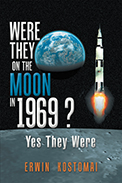
 |
In a society that is increasingly doubtful of history’s defining moments, from landing on the moon to September 11th, Kostomai’s work demonstrates the ideal method to present an argument and debunk conspiracy theorists. From the Mercury and Gemini programs that preceded Apollo to highlighting and examining every aspect of the Apollo missions, this text is supremely comprehensive and impartial. Both sides of the argument debating the factuality of the moon landing are portrayed concisely for the audience to reach their own judgment. The heart of the controversy is whether Neil Armstrong’s historic “leap for mankind” was orchestrated and intentionally misrepresented to the public during a time when multiple nations were part of the space race. While some critics like Bill Kaysing, a NASA scientist, claimed that the landing was scientifically improbable and unreliable, others cited Stanley Kubrick’s timing for his space film 2001: A Space Odyssey as a ploy to film the moon landing.
From a learning perspective, doubters and believers in the audience alike will learn a great deal about the science and process behind not just the moon landing but also about the history of the moon, the construction of the rocket engines, and the advent of digital technology, such as the Apollo's guidance computer—the first to function in real-time—in the late 1960’s that would inevitably ignite a technological revolution nearing the end of the twentieth and well into the twenty-first century. Through a combination of clear writing and well-researched graphics and charts, Kostomai’s work demonstrates how data can tell a story and present a compelling argument that conspiracy theorists will ultimately find difficult to deny.
RECOMMENDED by the US Review